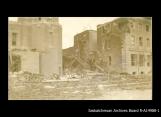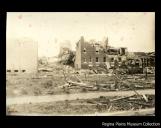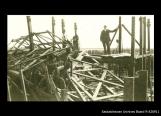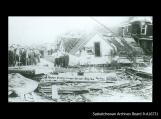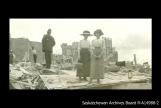1
The Tornado's Impact on Built and Physical Environments3
From the study of fire insurance plans and photographic evidence, one can acquire a clearer picture of how the built environment of the city was affected by the tornado.To help readers put things into perspective, we should share with them a sense of what the city was made of at the time. As any amateur historian who has looked at early photoraphs of Regina would know, the earliest buildings of 1883 were modest wooden structures, generally one or two storeys in height, interspersed with tents of all sizes. The first "movie theatre" in Regina was a tent - as was the first general store.
Bear in mind that all building materials had to be brought in by train as freight. As the 20th century rolled in, more sophisticated wooden structures started to appear, as well as taller brick and stone buildings. The former material sometimes was used as veneer over a wooden frame, and sometimes as structural bricks. But it is on wood structures that we will focus on for now.
5
If one follows the general path of the tornado from south to north, the first structures that were hit were mostly made of wood. They were wood-framed and wood-clad in most cases.Picture winds of hundreds of kilometers an hour hitting structures held together by masses of nails. Nails are an effective way to assemble dwellings when they are not subjected to an excessive amount of vibrations. This is why Inuit wood sleighs or kamotiks pulled over hard-packed snow and ice, over hundreds of kilometers, carrying food and people, are generally assembled today with nylon rope. The rope ensures the structural integrity of the sleigh by allowing vibrations between parts to take place. If there is a structural risk, it is the risk of the rope wearing out. When the rope becomes loose, it is simply tightened.
Nails, on the other hand, allow pieces to be pulled apart. This is why today's modern nails are sometimes coated in resin or spiraled, so they remain in place more effectively. Constant wind would inexorably weaken the bind that keeps clapboard and frames together, until pieces would come apart.
Wood is also a loftier material than brick or stone - not only because it is a less dense and heavy material, but because there is enough surface area to a wood board for any kind of wind to create a lift force. Thus planks have the potential to become the type of elongated missile that achieves great velocity in strong winds.
6
Large areas of debris were left behind by the tornado in residential areas around Regina.1912
Regina, Saskatchewan
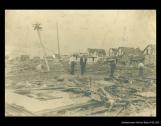
7
It then follows that photographic evidence suggests there were great concentrations of wooden debris after the tornado in the streets and yards of Regina. Our first reaction is to try to imagine just how terribly dangerous it must have been for a human being to be close to weak walls or unsheltered areas at the tornado's passage. Risk of injury was great and independent reports do confirm that there were many.9
The streets of Regina being mostly 66 feet wide - 99 feet for larger arteries - there was ample room for debris to spread over their surface. Larger "chunks", like an attic, a dormer or even perhaps an airborne roof, tended to wedge themselves next to other houses or buildings.10
Wreckage, including out buildings and an automobile behind a house on 14th avenue.1912
14th Avenue, Regina, Saskatchewan
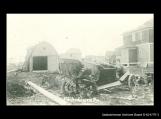
11
In the back lanes, there might have been considerably more clutter, as outhouses, sheds and stables are relatively flimsier structures. It seems there are fewer available photographs with perspectives from back lanes that were either taken or have survived as evidence for us to analyze.12
Debris blocking the space between the Metropolitan Methodist Church and the Y.W.C.A. on Lorne Street1912
Lorne Street, Regina, Saskatchewan
